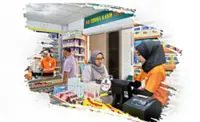We’re both art and design-led, Fictionist Studio founder Joanne Chew says, describing the ethos of the studio. — ART CHEN/The Star
ELEVEN years ago, Joanne Chew cast her ballot for the first time in a Malaysian general election. Chew, a Parsons School of Design alum, had up to that point spent most of her working life in New York and Singapore.
“Prior to 2014, I had not really worked in Malaysia for long enough to make a difference,” she recalls. But the act of voting sparked a desire to further play her part in shaping the future of the country.





